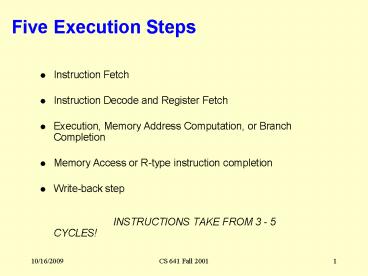Instruction Fetch - PowerPoint PPT Presentation
Title:
Instruction Fetch
Description:
Execution, Memory Address Computation, or Branch Completion ... It exploits parallelism among the instruction in a sequential instruction stream ... – PowerPoint PPT presentation
Number of Views:62
Avg rating:3.0/5.0
Title: Instruction Fetch
1
Five Execution Steps
- Instruction Fetch
- Instruction Decode and Register Fetch
- Execution, Memory Address Computation, or Branch
Completion - Memory Access or R-type instruction completion
- Write-back step INSTRUCTIONS TAKE FROM 3 - 5
CYCLES!
2
(No Transcript)
3
Step 1 Instruction Fetch
- Use PC to get instruction and put it in the
Instruction Register. - Increment the PC by 4 and put the result back in
the NPC. - Can be described succinctly using RTL
"Register-Transfer Language" IR
MemoryPC NPC PC 4What is the
advantage of updating the PC now?
4
Step 2 Instruction Decode and Register Fetch
- Read registers rs and rt in case we need them
- Compute the branch address in case the
instruction is a branch - RTL A RegIR25-21 B
RegIR20-16 aluout PC (sign-extend(IR15-
0)) - We aren't setting any control lines based on the
instruction type (we are busy "decoding" it in
our control logic)
5
Step 3 (instruction dependent)
- ALU is performing one of three functions, based
on instruction type - Memory Reference ALUOut A
sign-extend(IR15-0) - R-type ALUOut A op B
- Branch if (A op 0) PC ALUOut
6
Step 4 (R-type or memory-access)
- Loads and stores access memory MDR
MemoryALUOut or MemoryALUOut B - R-type instructions finish RegIR15-11
ALUOutThe write actually takes place at the
end of the cycle on the edge
7
Write-back step
- RegIR20-16 MDR
- What about all the other instructions?
8
Summary
9
Simple Questions
- How many cycles will it take to execute this
code? lw r2, 0(r3) lw r3, 4(r3) beqz r2,
Label assume not add r5, r2, r3 sw 8(r3),
r5Label ... - What is going on during the 8th cycle of
execution? - In what cycle does the actual addition of r2 and
r3 takes place?
10
Enhancing Performance
- Pipelining is an implementation technique in
which multiple instructions are overlapped in
execution - It improves instruction throughput rather than
individual instruction execution time - It exploits parallelism among the instruction in
a sequential instruction stream - Under ideal conditions the speedup from
pipelining equals the number of pipe stages - But there is some overhead associated with
pipelining so SU is not ideal - No stage may be faster than the slowest stage of
the pipe, or to put it another way, the slowest
instruction determines the total time for the pipe
11
Pipeline Example
- From HP, have seven single-cycle instructions
with various timings in a five-stage pipe - Sequential execution
12
Pipeline Example (Contd)
- Using a 2 nsec clock cycle with pipelining
- Recall that pipelining improves performance by
increasing instruction throughput as opposed to
decreasing the execution time of an individual
instruction - Notice the idle time in the pipe at certain times
13
Pipeline Performance
- Ideal speedup is number of stages in the
pipeline. Do we achieve this? - Throughput º task completed / unit time
- Given k tasks and an n-stage pipeline where each
stage takes the same unit of time to process and
task arrive at the same unit time intervals - It takes n time units to fill pipeline and
process first task - Thereafter, pipeline processes 1 task every unit
of time
Tp(k,n) n (k-1)
k
Throughput
n (k - 1)
14
Computer Pipelines
- Execute billions of instructions, so throughout
is what matters - DLX desirable features all instructions same
length, registers located in same place in
instruction format, memory operands only in loads
or stores
15
5 Steps of DLX DatapathFigure 3.1, Page 130
Memory Access
Write Back
Instruction Fetch
Instr. Decode Reg. Fetch
Execute Addr. Calc
IR
L M D
16
Pipelined DLX DatapathFigure 3.4, page 137
Instruction Fetch
Instr. Decode Reg. Fetch
Execute Addr. Calc.
Write Back
Memory Access
- Data stationary control
- local decode for each instruction phase /
pipeline stage
17
Graphically Representing Pipelines
?1998 Morgan Kaufmann Publishers
- Need to answer questions like
- How many cycles does it take to execute this
code? - What is the ALU doing during cycle 4?
- Use this representation to help understand
datapaths
ALU
ALU
18
Visualizing PipeliningFigure 3.3, Page 133
Time (clock cycles)
I n s t r. O r d e r































